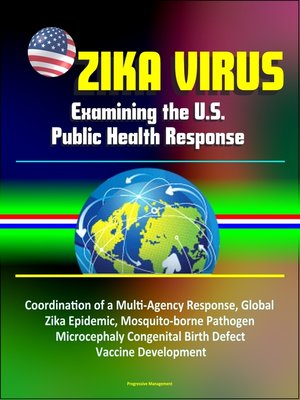Zika Virus
ebook ∣ Examining the U.S. Public Health Response, Coordination of a Multi-Agency Response, Global Zika Epidemic, Mosquito-borne Pathogen, Microcephaly Congenital Birth Defect, Vaccine Development
By Progressive Management

Sign up to save your library
With an OverDrive account, you can save your favorite libraries for at-a-glance information about availability. Find out more about OverDrive accounts.
Find this title in Libby, the library reading app by OverDrive.



Search for a digital library with this title
Title found at these libraries:
| Loading... |
Professionally converted for accurate flowing-text e-book format reproduction, this report presents the testimony at recent hearings about the ongoing Zika virus crisis. The House Subcommittee on Oversight and Investigations for the Committee on Energy and Commerce held a hearing called Examining the U.S. Public Health Response to the Zika Virus. This virus of mosquito-borne pathogen is currently rampaging through South and Central America, and in total has spread to more than 48 countries and territories. While as of late February there have been no known locally-acquired mosquito-borne cases reported in the Continental U.S., over 100 travel-associated Zika Virus cases have been identified in over 20 states. Outside of the 50 states local mosquito-borne transmissions have been reported in Puerto Rico, the U.S. Virgin Islands, and American Samoa. Public health officials in the U.S. are bracing for the time when Zika passes from a traveler with Zika in his or her blood to a local mosquito, and then to another person. Only about one and five people with Zika infection exhibit symptoms, most of which are mild and flu-like. Of greater concern is growing evidence of a link between Zika infection and microcephaly, a congenital birth defect in infants born to infected mothers, as well as Guillain-Barre Syndrome, an immune disorder that can result in temporary paralysis. On this basis, the World Health Organization recently declared Zika a public health emergency of international concern.
The virus may also be transmitted through blood transfusions and sex leaving the Center for Disease Control to issue interim guidelines for prevention of sexual transmission, and the Food and Drug Administration to take steps to reduce the risk to the U.S. blood supply. Thus far, there has been only one reported case in the U.S. of a child born with microcephaly to a mother with travel-associated Zika Virus. However, another pregnant American woman other pregnant American women have become infected with Zika. Our understanding of how the virus may impact a developing child during pregnancy is nearly non-existent. We can, however, reasonably assume that a virus affecting development of the brain on a large scale leading to microcephaly in the first trimester will also impact significant developmental functions for infants, toddlers, and children exposed to the Zika Virus. These include my concerns for developmental disorders of difficulty with learning, primary sensory and sensory integration, memory, attention, concentration, behavior, mood, language, motor, and others. Given all of the unknowns the importance of acting now to protect pregnant women and women of reproductive age from exposure to Zika Virus cannot be overstated. However, we must be equally concerned with protecting infants and children with developing brains and not wait five to ten years for symptoms to appear before we take action to protect, to track, and to treat.






